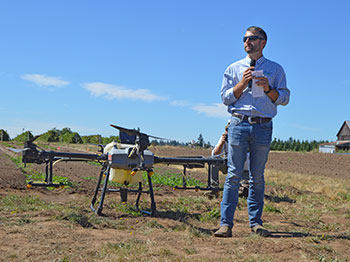Drone Applications Proving Effective Against SWD
Use of drones for spotted wing drosophila sprays is proving to be an effective alternative to ground applications, according to a report on the technology aired July 24 at the OSU Blueberry Field Day.
 |
Speaking at the OSU Blueberry Field Day, Chris Kaiser of Pratum Co-op, said his company has used drones to treat roughly 7,000 acres of blueberries and blackberries for spotted wing drosophila over the past year. |
Chris Kaiser, of Pratum Co-op in Salem, said the full-service ag retail company has treated about 19,000 acres for SWD with drones over the last year-and-a-half, including 7,000 acres of blueberries and blackberries.
“We have also applied copper after pruning and fungicides in the spring for mummy berry,” Kaiser said. “So, we’ve done a lot of work in 2022 and 2023 in figuring out our efficacy and coverage.”
Volume capacities of its drones have varied from about seven-and-a-half gallons to up to thirteen-and-a-half gallons with a more recently purchased model, Kaiser said.
He noted that the company has been getting excellent results using medium to medium-fine droplet nozzles and low carrier volume.
“We’re still putting the same amount of chemical out per acre, but the carrier volume is a lot lower, therefore it is a more concentrated application,” he said.
Kaiser said there are multiple benefits of using drones in blueberries, including improved coverage, minimum to no fruit knockdown during applications and reduced labor costs.